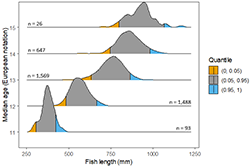Auxillary Information
Last modified on Jan 21, 2021
Auxiliary data, such as fish length, scale size, sex, and sample date can narrow the range of possible ages and increase a reader's confidence in an age estimate; however, the impact of auxiliary information on the accuracy of age estimate is mixed. Such data can both reduce error and introduce bias (Morison et al. 1998). The ability to use auxiliary data to increase accuracy of age estimates without introducing bias is a skill that is developed by learning life histories and growth patterns in combination with recent population age trends.
Length
Length information is helpful for estimating age because age increases with fish length; however, there are two main exceptions to this rule. First, there is overlap in the length distributions at age, especially for older ages (Campana 2001; Figure 1). A review of 108 Chinook salmon variation in size and age revealed considerable variability in fish length-at-age among populations and inconsistent length-at-age relationships between sexes and years (Roni and Quinn 1995). Additionally, trends in length-at-age have changed over time for some North Pacific Chinook salmon populations (Bigler et al. 1996; Lewis et al. 2015; Ohlberger et al. 2018; Ricker 1981), so length-frequency tables developed for one year may not apply to a different year. Within a year, length-frequency tables can corroborate an age estimate; however, length alone does not provide independent evidence that a length range represents an age class (see age validation).
Scale size
Scale size is proportional to fish length (Clutter and Whitesel 1956; Francis 1990), thus scale size is broadly useful for age estimation. However, scale size and shape vary by sampling location on the fish (Scarnecchia 1979). Scales taken from the preferred area of a fish (three scale rows above the lateral line between the posterior insertion of the dorsal fin and anterior insertion of the anal fin; Scarnecchia 1979) tend to be large, have high circuli counts (Clutter and Whitesel 1956), and are dorsal-ventrally symmetrical. Scales taken from other areas tend to be smaller, have fewer circuli, show proportionally less early growth (Scarnecchia 1979), and be less symmetrical (i.e.; circular in shape or skewed dorsal-ventrally). Exceptions in scale shape and size may indicate that a scale came from an older fish than expected.
Sex
Sex is not informative to fish age, because although age-sex relationships exist, they are variable, so provide unreliable information for age estimation. In most Chinook salmon populations, males are smaller and vary more in size and age at maturity than females (Quinn 2005); however, the high variability in the size and age of males reduces the applicability of sex information to age estimation.
Sample date
Sample day is informative to fish age because within populations, there are general trends in age at return over the sample year, where older and larger fish generally precede younger and smaller fish during their spawning migration (Quinn 2005), and there is an interaction between sample day of year and fish age (Bilton and Ludwig 1966). At a given sample day, younger fish will show more growth of a year on a scale than older fish, which is helpful for interpreting growth patterns on the outer margin of the scale (see age estimation).
References
Bigler, B. S., D. W. Welch, and J. H. Helle. 1996. A review of size trends among North Pacific salmon (Oncorhynchus spp.). Canadian Journal of Fisheries and Aquatic Sciences 53: 455-465.
Campana, S. 2001. Accuracy, precision and quality control in age determination, including a review of the use and abuse of age validation methods. Journal of Fish Biology 59(2): 197-242.
Clutter, R., and L. Whitesel. 1956. Collection and interpretation of sockeye salmon scales, volume 9. International Pacific Salmon Fisheries Commission Bulletin, New Westminster, Canada.
Francis, R. I. C. C. 1990. Back-calculation of fish length: a critical review. Journal of Fish Biology 36: 883-902.
Lewis, B., W. S. Grant, R. E. Brenner, and T. Hamazaki. 2015. Changes in Size and Age of Chinook Salmon Oncorhynchus tshawytscha Returning to Alaska. PloS one 10(6): e0130184.
Morison, A. K., S. G. Robertson, and D. C. Smith. 1998. An integrated system for production fish aging: image analysis and quality assurance. North American Journal of Fisheries Management 18(3): 587-598.
Ohlberger, J., E. J. Ward, D. E. Schindler, and B. Lewis. 2018. Demographic changes in Chinook salmon across the Northeast Pacific Ocean. Fish and Fisheries 19(3): 533-546.
Roni, P., and T. P. Quinn. 1995. Geographic variation in size and age of North American chinook salmon. North American Journal of Fisheries Management 15(2): 325-345.
Ricker, W. 1981. Changes in the average size and average age of Pacific salmon. Canadian Journal of Fisheries and Aquatic Sciences 38(12): 1636-1656.
Scarnecchia, D. L. 1979. Variation of scale characteristics of coho salmon with sampling location on the body. The Progressive Fish-Culturist 41(3): 132-135.

